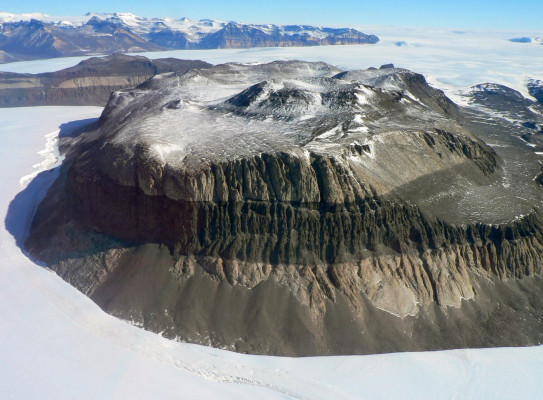
Friis Hills Drilling ProjectUncovering the secrets of Antarctica's past to understand our future

Over the summer of 2016/17, a team drilled sediment cores on the summit of Friis Hills to understand Antarctica’s past climate.
Overview
Led by GNS Science and Victoria University of Wellington Te Herenga Waka, with Richard Levy and Tim Naish as co-lead scientists, the project team carried out an ambitious and challenging drilling programme over the Antarctic summer season of 2016-17. The drilling team included Alex Pyne from VUW and Tony Kingan and Adam Rutten from Porirua-based Webster Drilling and Exploration. The extensive Antarctic drilling experience offered by this team allowed recovery of a near continuous composite 80m thick sediment core from three locations in the Friis Hills.
The project
The spectacular Friis Hills
The Hills are located at the bend of the Taylor Glacier, in the McMurdo Dry Valleys of Antarctica. It contains a unique sequence of sediments deposited approximately 15 million years ago as glaciers advanced and retreated across a landscape that was periodically covered by lakes, rivers, and tundra vegetation. Sediments of this age are incredibly rare in Antarctica. The paleoenvironmental and paleontological information and data that the cores contain are critical to guide our understanding of Antarctica’s past climatic and glacial conditions.
How the team got the critical data
The team drilled very early in the season to take advantage of the cold temperatures so that the permafrost sediments did not melt. Each core section was wrapped in lay-flat tubing, stored in ice-core boxes, and transported by helicopter to a freezer lab at Scott Base, where they were X-rayed. All cores were subsequently shipped to the National Ice Core Facility, housed at the GNS Science campus in Gracefield, Lower Hutt where they are carefully stored to this day. The facility manager, Rebecca Pyne, also helped curate the cores in the field. Scientists continue to examine and re-examine these valuable repositories.
The cores we drilled on the summit of Friis Hills contain valuable insights into the past. They also give us a glimpse of what may happen in Antarctica, if we fail to meet our CO2 emission goals and reach net zero targets by 2050.
What the Friis Hills data has been used for
So far, the Friis Hills data has been used to uncover past climatic conditions in the Transantarctic Mountains, summarised in the following:
-
Meteoric Beryllium-10 in Miocene permafrost and the advent of persistent polar aridity in East Antarctica, 2023
Richard was a co-author of the paper published in Nature Geoscience, entitled 'Meteoric Beryllium-10 in Miocene permafrost and the advent of persistent polar aridity in East Antarctica'.
The lead author, Dr Marjolaine Verret, studied Beryllium-10 concentrations in 64 samples from the rock cores, as part of her PhD studies at Te Herenga Waka - Victoria University. The researchers were attempting to determine when the mountains surrounding the McMurdo Dry Valleys last had water.
What they found in fact was strong evidence that water infiltrated the ground until the late Miocene, much later than previously suggested, and that the Dry Valleys shifted in intervals between a warm-wet climate and the dry polar aridity of today.
-
East Antarctic Ice Sheet variability during the middle Miocene Climate Transition captured in drill cores from the Friis Hills, Transantarctic Mountains, 2022
Joe Prebble and Richard Levy from GNS Science were co-authors of the 2022 paper ‘East Antarctic Ice Sheet variability during the middle Miocene Climate Transition captured in drill cores from the Friis Hills, Transantarctic Mountains’. Published in the GSA Bulletin, Volume 135, the lead author was Dr Hannah Chorley.
The paper focuses on the middle Miocene and its relevance to understanding the response of the East Antarctic Ice Sheet (EAIS) to future anthropogenic climate change.
The research revealed that variations between glacial and interglacial periods were influenced by astronomical factors, particularly precession and eccentricity cycles. By combining geological observations, earth system modelling, and data analysis, Dr Chorley investigated the relationship between declining carbon dioxide (CO2) concentrations and the size and sensitivity of ice sheets in the past.
By analysing the cores, the research indicated that the deposits from successive interglacial periods during the middle Miocene had similar environmental conditions, suggesting that the Friis Hills hinterland was likely ice-free. The study further revealed that expansion of the ice sheet and major changes in the layers coincided with specific points in the eccentricity cycles. The findings suggest that the ice sheet experienced cyclical expansion and contraction over 100,000-year intervals during warm periods in the middle Miocene. After 14.5 million years ago, changes in obliquity became more significant, leading to large parts of the Antarctic Ice Sheet grounding in marine environments.
-
Cryostratigraphy of mid-Miocene permafrost at Friis Hills, McMurdo Dry Valleys of Antarctic, 2020
In 2020, Richard Levy was a co-author of ‘Cryostratigraphy of mid-Miocene permafrost at Friis Hills, McMurdo Dry Valleys of Antarctic’.
Lead author Dr Marjolaine Verret says “The Friis Hills permafrost cores contain a unique cryostratigraphic assemblage with ground ice present to depths of 50 m. This provides a rare opportunity to study ground ice encased within Miocene-aged sediments.”
Two ice lenses, 2- and 15-cm thick, were found at 37 and 43 m depths, respectively. Although these ice lenses could not be dated directly, the fact that they lie below the depth of zero thermal amplitude, and that their isotopic signature suggests that they originated from the freezing of meteoric water both support that they were emplaced following the deposition of the sediments during the mid-Miocene, approximately 14 million years ago. This would potentially make this ice the oldest ground ice reported in any permafrost region. In comparison, the oldest ice core record, EPICA Dome C, dates back 800 000 years.
Richard Levy says that the ongoing research underscores how the examination of these frozen rocks can help guide and inform our future. They also provide important context for the SWAIS 2C programme, project managed by GNS Science, which will undertake its first Antarctic season later this year.
“The data obtained from the Friis Hills cores mirror similar results from offshore drilling projects and modelling studies. These indicate that if Earth’s average climate warms above a threshold of around 400ppm of atmospheric CO2, Antarctica may not be able to sustain marine-based ice sheets.
“Today, CO2 concentrations are around 416 ppm - and climbing. We have potentially crossed a key climate threshold, thereby reversing a major cooling step in the Cenozoic evolution of Earth’s climate system that has lasted for approximately 13 million years.”
Other personnel from GNS Science who have contributed to the Friis Hills Drilling Project include Roger Tremain and Te Aomania Te Koha.
Banner image credit: Friis Hills & Taylor Glacier. East Antarctica Ice Sheet Beyond, Adam Lewis.

Research project details
Collaborators:
ARC, Victoria University of Wellington Te Herenga Waka
Otago University
Duration
Fieldwork: Summer 2016-17
Funding platform
Antarctic Science Platform (MBIE)
Status
Current
Leaders
Richard Levy (GNS Science/VUW)
Tim Naish (ARC VUW)